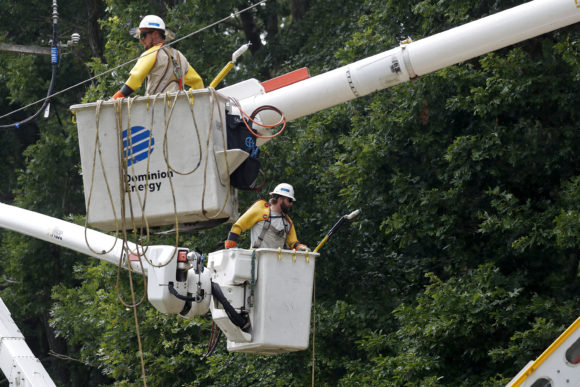YORKTOWN, Va. — The line crew from Northern Virginia had been working since 7 a.m., knocking out six repair jobs to restore power to hundreds of Peninsula homes, but the backlog at Dominion Energy’s regional operations center meant they got a bit of an early afternoon breathing spell at job No. 7.
They had little choice — the operations center turns off the electricity on a line — and the job they were about to tackle involved a lot of electricity, 34,500 volts feeding some 700 York County customers, including Dominion’s own power station in Yorktown.
The storm snapped a 50-foot tall, 12-inch thick pine tree, bringing down the neutral wire that completed the electrical circuit on the Dominion’s five-mile 401 line, which runs along the CSX tracks in Seaford. The tree put enough weight on the two sets of three live conductor wires to break the ends off two cross arms on a nearby pole.
“Lucky it was just a pine tree, they’re not as heavy,” said Gary Pultz, a Dominion safety performance specialist working with the crew.
Though it was a big job, affecting a lot of customers, it couldn’t be tackled until a railroad crew cleared the fallen pine. Access is one reason why some jobs start later than others.
Then, too, it takes a lot of coordination, which takes time, to deal safely with 34,500 volts.
And then, as lineman Andrew Dodson found, once one of the crew’s bucket trucks had hoisted him 40 feet up, you can spot problems that neither an on-the-ground patrol nor a overflying drone can see.
`Open And Tagged’
When they got the word the regional operations center was ready, D.J. Uffelman and his team set off for one end of the 401 line, his friend Dan Friot to the other, five miles off.
Uffelman waited at the western end of the 401 for the center to send its electronic signal open the “reclosers”– the switches that connect the line to the rest of Dominion’s system — to start to isolate the line.
There’s a three-step back and forth between the center and the crews in which the one tells the other what it plans to do. The crew then confirms it understands; the center then disconnects the circuit, tells the crew, which acknowledges and then advises that the circuit is no longer energized.
But when you’re dealing with 34,500 volts, you want to make sure.
That’s when it became Uffelman’s job to use his 40-foot extender pole to reach up to the disconnect ? the 18-inch-long bar attached to each recloser _ and open it. The disconnect is a backstop, in case the internal switch in the recloser malfunctions.
There were six at his end of the line, one for each of the 401’s six conducting wires. Being able to maneuver a 40-foot-line pole to flip open an 18-inch disconnect is just one of the things a lineman needs to know how to do.
Opening the disconnect physically separates the 401’s wires from the electricity pulsing through the rest of Dominion’s system.
Uffelman then used the same extender to check voltages on either side of each recloser, making sure that noting is getting across to the 401. That done, he used the pole to attach a bright red tag to a cross-arm, a signal that there were people working on the wire and it needed to remain dead.
Five miles away, Friot was doing the same, though he had a few extra things to take care of.
It took about 40 minutes. Once done, Friot huddled with Uffelman. “401 R-zero open and tagged,” he said. “Bypass open and tagged. Line side taps, open and tagged, Two sets of Ds (disconnects) open and tagged.”
The 401 was now isolated. “In a box,” Uffelman said.
About the photo: Andrew Dodson, left, and Scott Crane, of Dominion Energy work to repair a fallen electrical line near Newsome Drive in York County, Va. Wednesday afternoon, Aug. 5, 2020 after multiple trees were toppled by Tropical Storm Isaias. Power would be restored to more than 700 customers once the work was completed. (Jonathon Gruenke/The Daily Press via AP)
Was this article valuable?
Here are more articles you may enjoy.


 US Weather Service Merges Units as Staffing Pressure Rises
US Weather Service Merges Units as Staffing Pressure Rises  Oracle Warns Health Customers of Patient Data Breach
Oracle Warns Health Customers of Patient Data Breach  Alibaba Teams up With BMW to Develop AI for Cars in China
Alibaba Teams up With BMW to Develop AI for Cars in China  After the Flames: Preparing for the Growing Fraud Threat in Los Angeles
After the Flames: Preparing for the Growing Fraud Threat in Los Angeles 